实验3:OpenFlow协议分析实践
作业链接:实验3:OpenFlow协议分析实践
一、实验目的
- 能够运用 wireshark 对 OpenFlow 协议数据交互过程进行抓包;
- 能够借助包解析工具,分析与解释 OpenFlow协议的数据包交互过程与机制。
二、实验环境
- 下载虚拟机软件Oracle VisualBox;
- 在虚拟机中安装Ubuntu 20.04 Desktop amd64,并完整安装Mininet;
三、实验要求
(一)基本要求
1.搭建下图所示拓扑,完成相关 IP 配置,并实现主机与主机之间的 IP 通信。用抓包软件获取控制器与交换机之间的通信数据包。
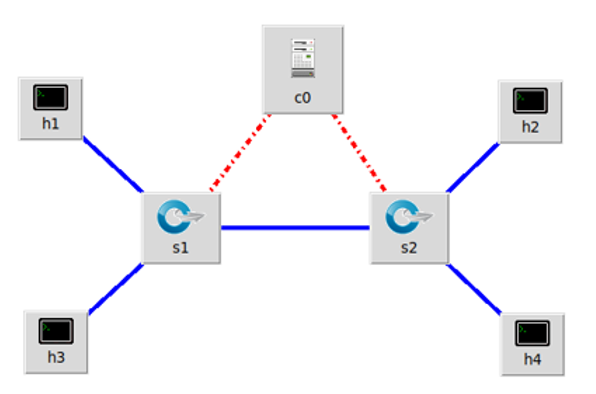
| 主机 | IP地址 |
|---|---|
| h1 | 192.168.0.101/24 |
| h2 | 192.168.0.102/24 |
| h3 | 192.168.0.103/24 |
| h4 | 192.168.0.104/24 |
- 构建拓扑
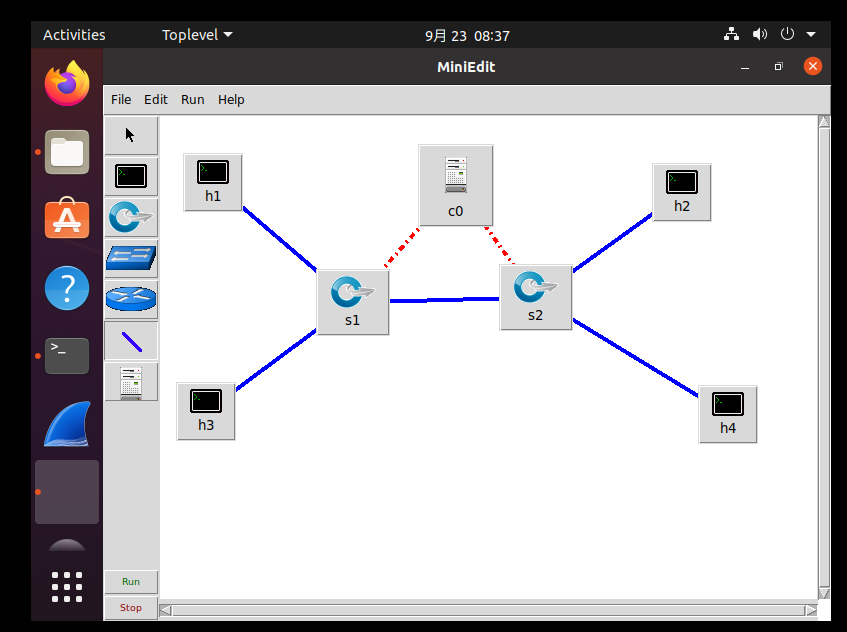
- 配置子网掩码和ip地址(只给出h1和h2的ip配置,其他是一样的)
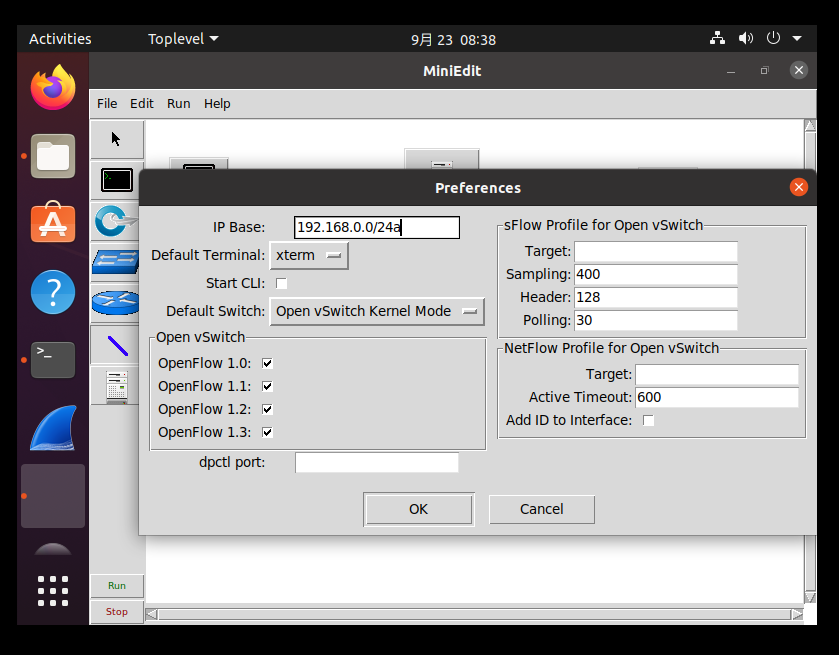
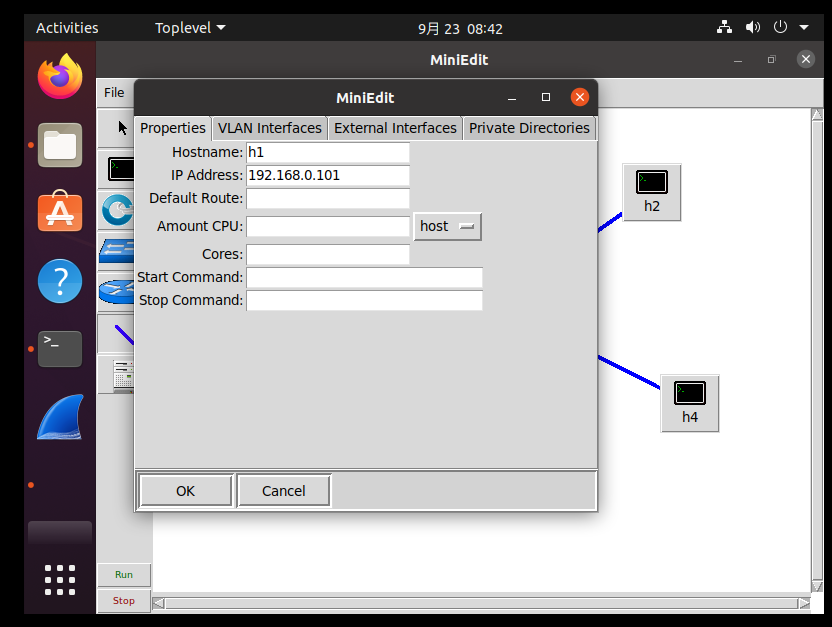
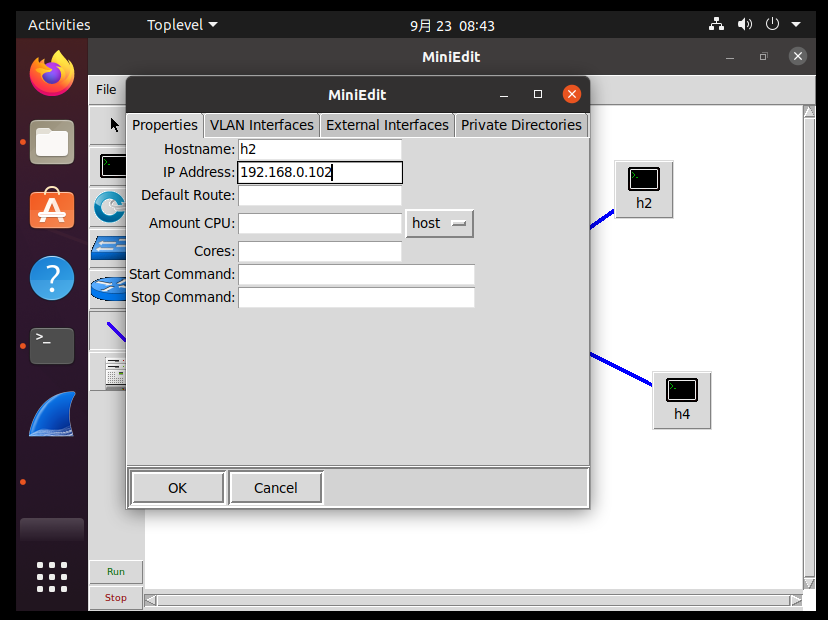
- 检查
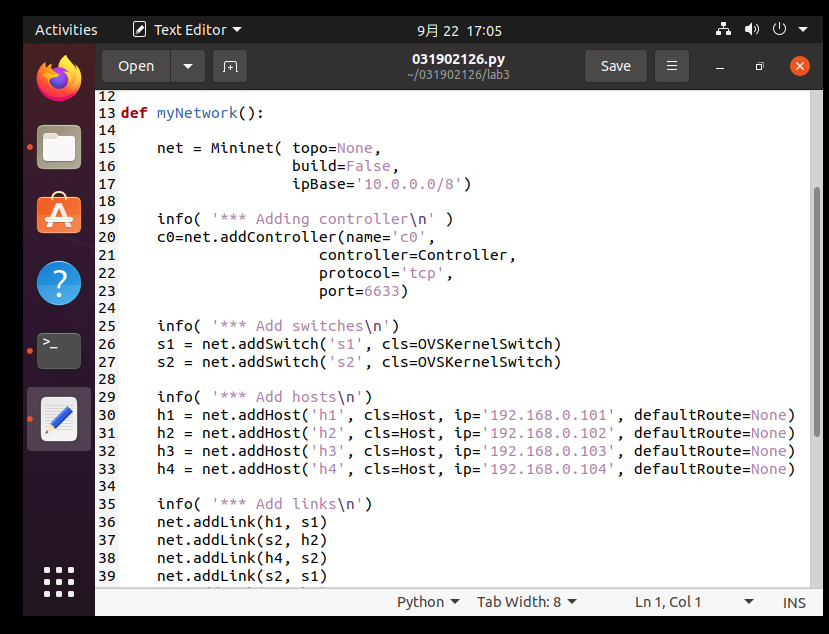
2.查看抓包结果,分析OpenFlow协议中交换机与控制器的消息交互过程,画出相关交互图或流程图。
- 在构建拓扑之前打开wireshark(选择any),然后运行文件并pingall。

- 查看抓的包
1.OFPT_HELLO
从6633端口到43820端口,openflow1.0协议
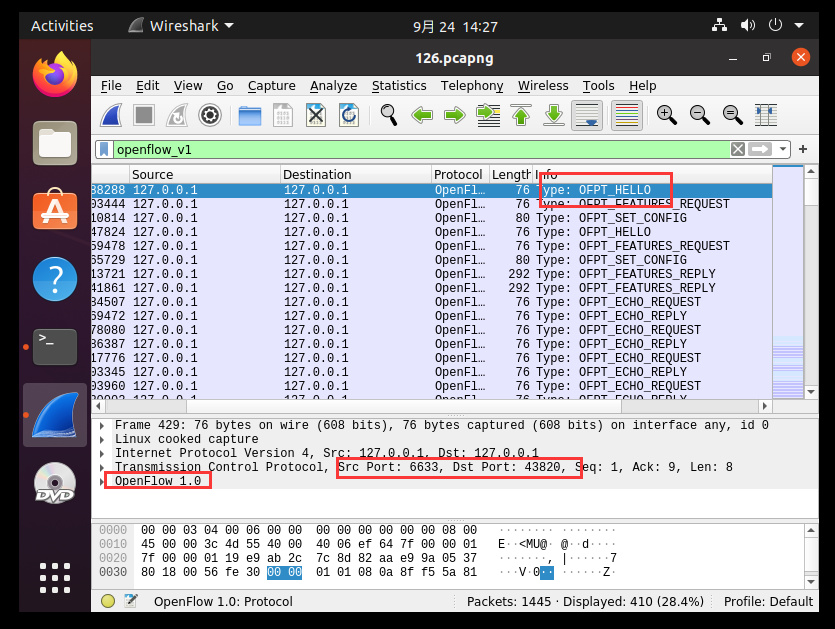
从43820端口到6633端口,openflow1.5协议

2.OFPT_FEATURES_REQUEST 从6633端口到43820端口
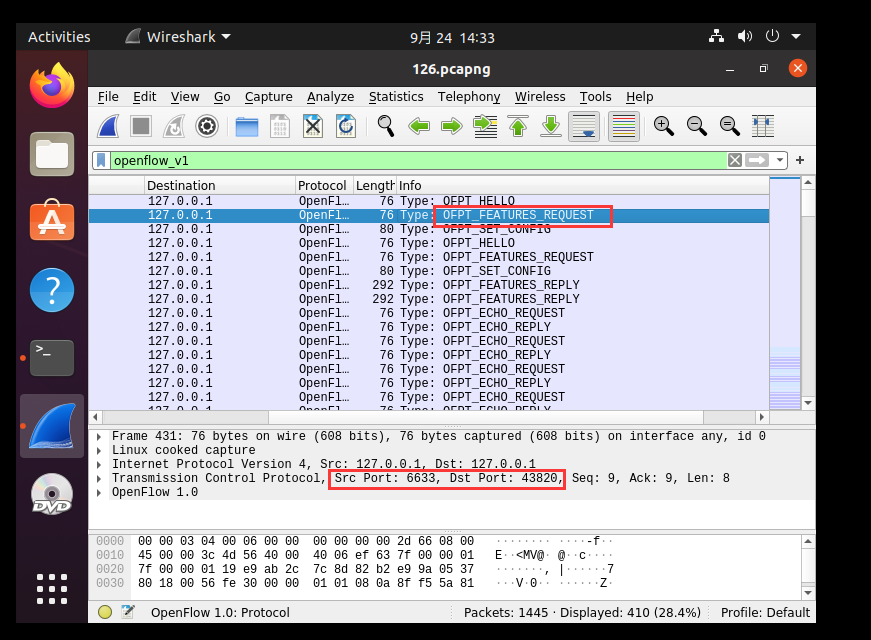
3.OFPT_SET_CONFIG 从6633端口到43820端口

4.OFPT_PORT_STATUS 从43820端口到6633端口
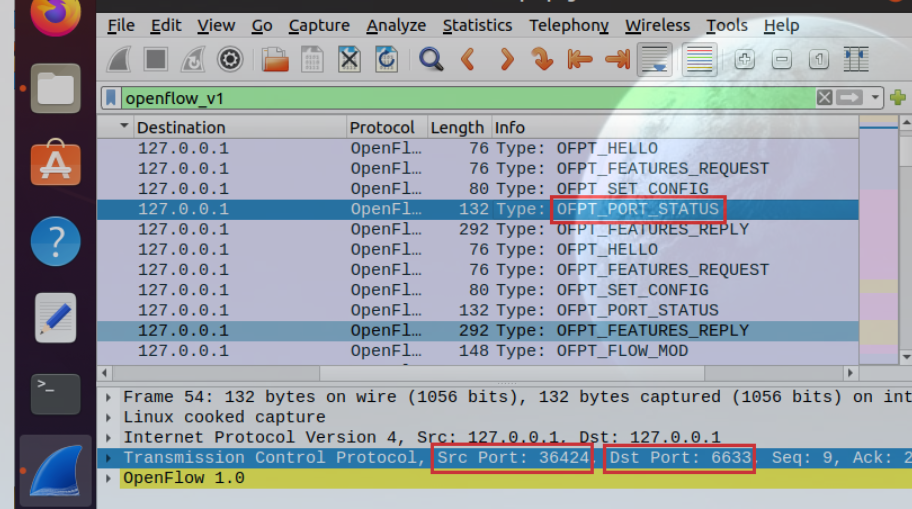
5.OFPT_FEATURES_REPLY 从43820端口到6633端口

6.OFPT_PACKET_IN 从43820端口到6633端口

7.OFPT_PACKET_OUT 从6633端口到43820端口
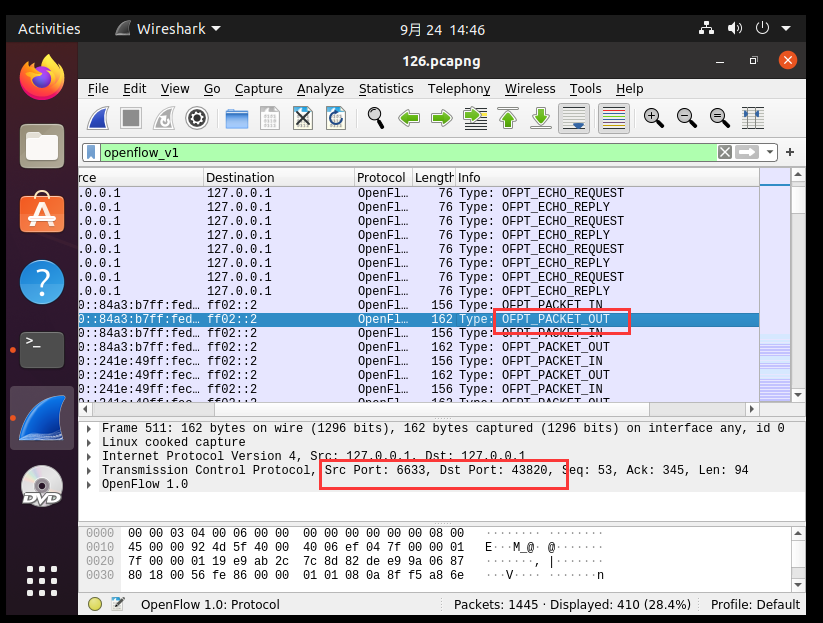
8.OFPT_FLOW_MOD 从6633端口到43820端口
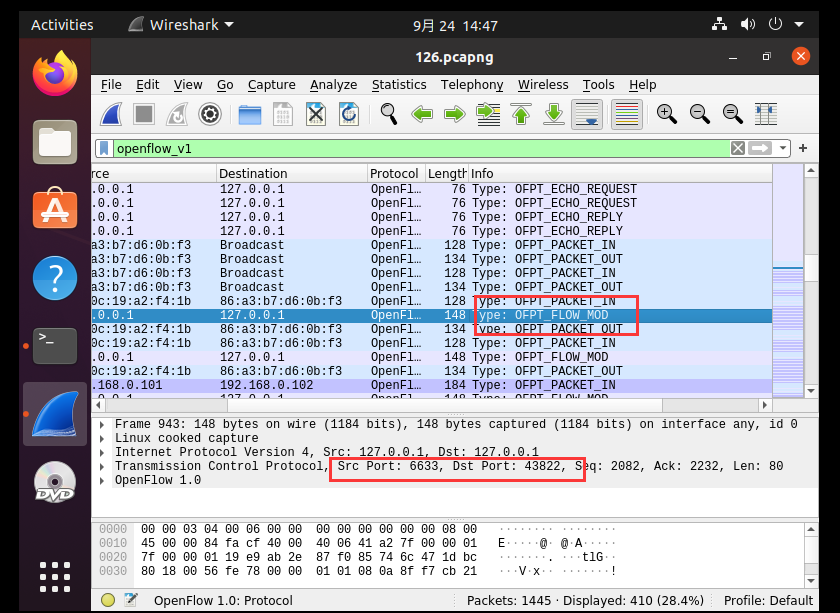
- 对应流程图如下:
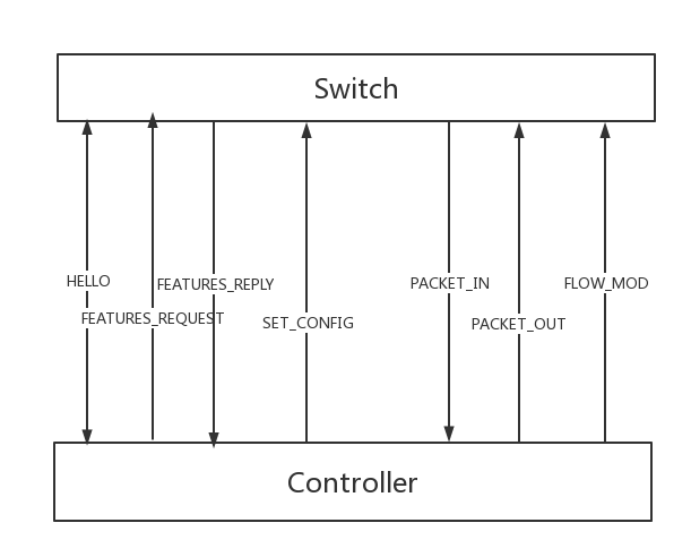
3.回答问题:交换机与控制器建立通信时是使用TCP协议还是UDP协议?
Transmission Control Protocol即TCP协议
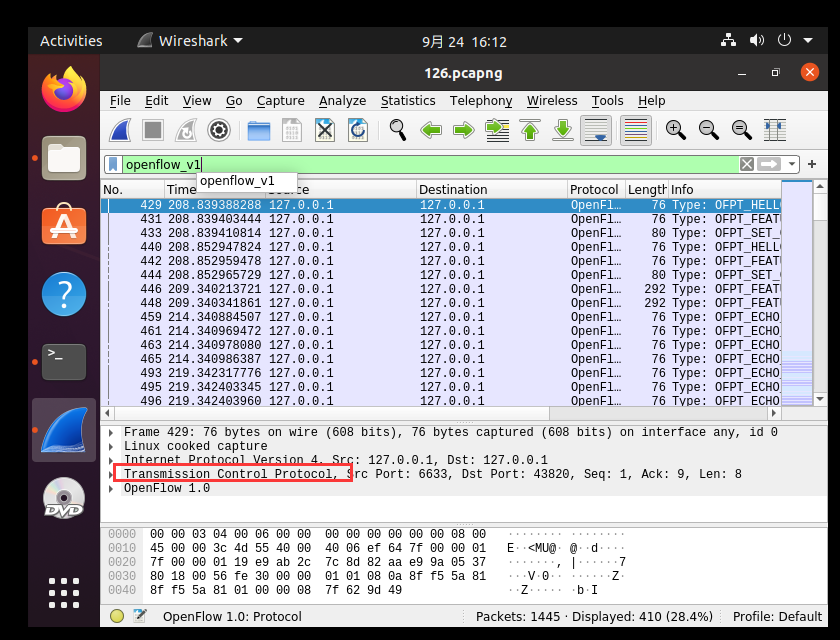
(二)进阶要求
将抓包结果对照OpenFlow源码,了解OpenFlow主要消息类型对应的数据结构定义。
1.HELLO
struct ofp_header {
uint8_t version; /* OFP_VERSION. */
uint8_t type; /* One of the OFPT_ constants. */
uint16_t length; /* Length including this ofp_header. */
uint32_t xid; /* Transaction id associated with this packet.
Replies use the same id as was in the request
to facilitate pairing. */
};
struct ofp_hello {
struct ofp_header header;
};
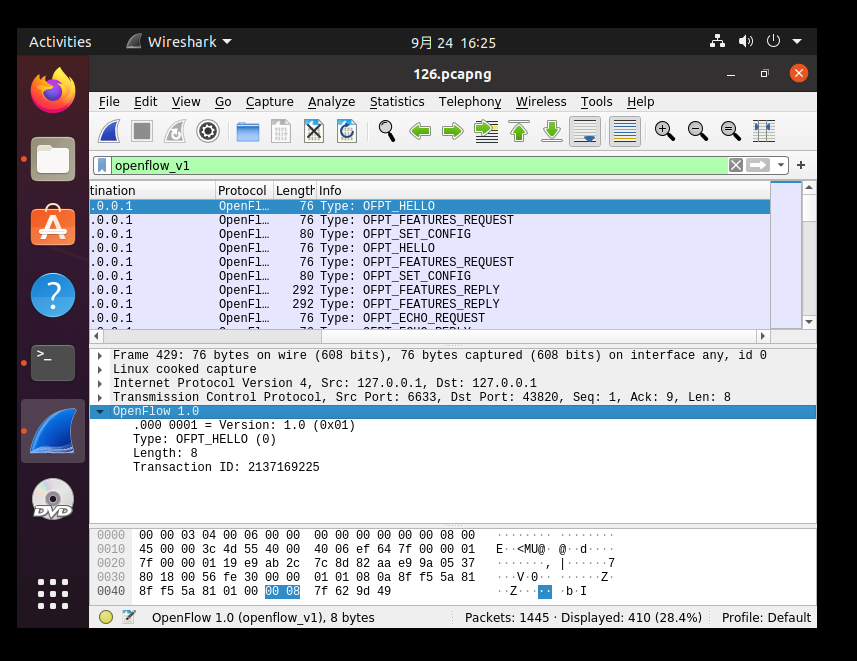
2.OFPT_FEATURES_REQUEST
源码与HELLO类似

3.OFPT_SET_CONFIG
/* Switch configuration. */
struct ofp_switch_config {
struct ofp_header header;
uint16_t flags; /* OFPC_* flags. */
uint16_t miss_send_len; /* Max bytes of new flow that datapath should
send to the controller. */
};
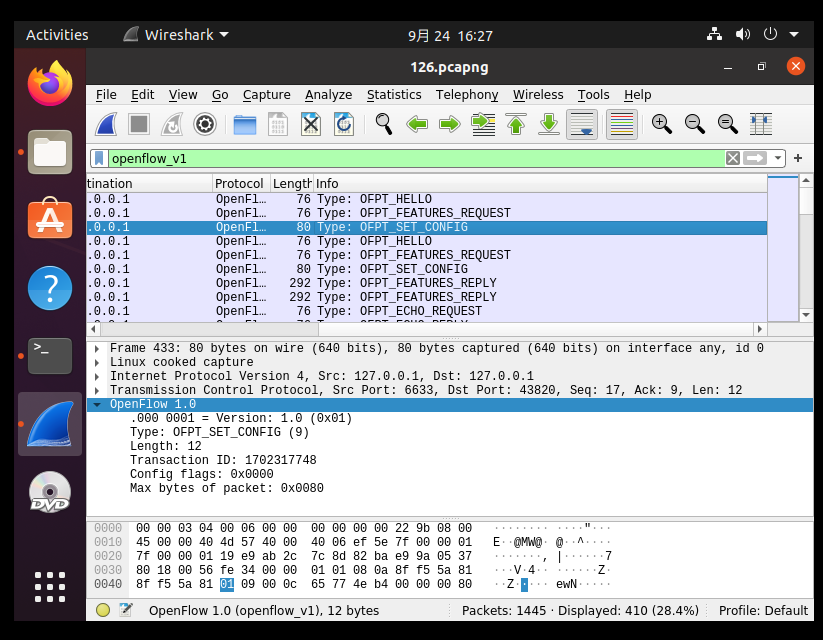
4.OFPT_PORT_STATUS
/* A physical port has changed in the datapath */
struct ofp_port_status {
struct ofp_header header;
uint8_t reason; /* One of OFPPR_*. */
uint8_t pad[7]; /* Align to 64-bits. */
struct ofp_phy_port desc;
};

5.OFPT_FEATURES_REPLY
struct ofp_switch_features {
struct ofp_header header;
uint64_t datapath_id; /* Datapath unique ID. The lower 48-bits are for
a MAC address, while the upper 16-bits are
implementer-defined. */
uint32_t n_buffers; /* Max packets buffered at once. */
uint8_t n_tables; /* Number of tables supported by datapath. */
uint8_t pad[3]; /* Align to 64-bits. */
/* Features. */
uint32_t capabilities; /* Bitmap of support "ofp_capabilities". */
uint32_t actions; /* Bitmap of supported "ofp_action_type"s. */
/* Port info.*/
struct ofp_phy_port ports[0]; /* Port definitions. The number of ports
is inferred from the length field in
the header. */
};
/* Description of a physical port */
struct ofp_phy_port {
uint16_t port_no;
uint8_t hw_addr[OFP_ETH_ALEN];
char name[OFP_MAX_PORT_NAME_LEN]; /* Null-terminated */
uint32_t config; /* Bitmap of OFPPC_* flags. */
uint32_t state; /* Bitmap of OFPPS_* flags. */
/* Bitmaps of OFPPF_* that describe features. All bits zeroed if
* unsupported or unavailable. */
uint32_t curr; /* Current features. */
uint32_t advertised; /* Features being advertised by the port. */
uint32_t supported; /* Features supported by the port. */
uint32_t peer; /* Features advertised by peer. */
};

6.OFPT_PACKET_IN
struct ofp_packet_in {
struct ofp_header header;
uint32_t buffer_id; /* ID assigned by datapath. */
uint16_t total_len; /* Full length of frame. */
uint16_t in_port; /* Port on which frame was received. */
uint8_t reason; /* Reason packet is being sent (one of OFPR_*) */
uint8_t pad;
uint8_t data[0]; /* Ethernet frame, halfway through 32-bit word,
so the IP header is 32-bit aligned. The
amount of data is inferred from the length
field in the header. Because of padding,
offsetof(struct ofp_packet_in, data) ==
sizeof(struct ofp_packet_in) - 2. */
};
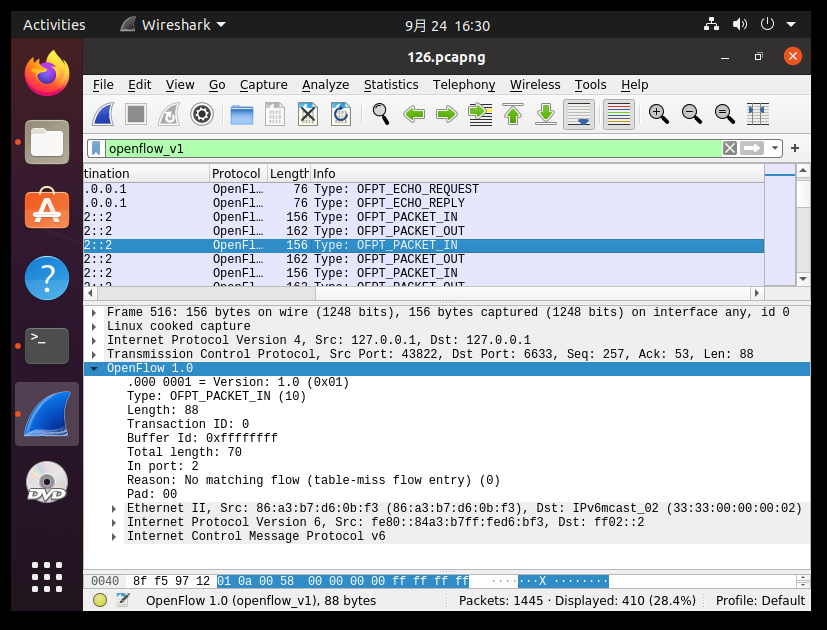
7.OFPT_PACKET_OUT
struct ofp_packet_out {
struct ofp_header header;
uint32_t buffer_id; /* ID assigned by datapath (-1 if none). */
uint16_t in_port; /* Packet's input port (OFPP_NONE if none). */
uint16_t actions_len; /* Size of action array in bytes. */
struct ofp_action_header actions[0]; /* Actions. */
/* uint8_t data[0]; */ /* Packet data. The length is inferred
from the length field in the header.
(Only meaningful if buffer_id == -1.) */
};
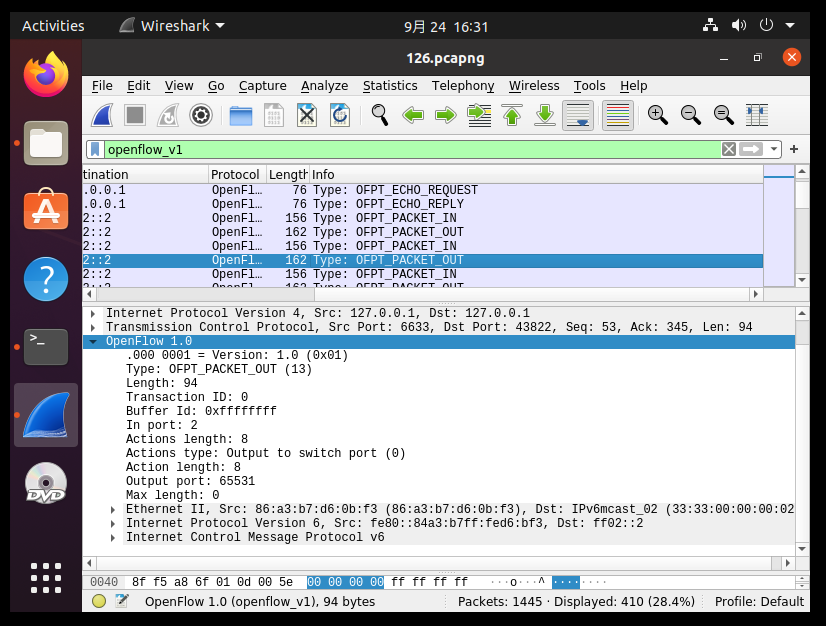
8.OFPT_FLOW_MOD
struct ofp_flow_mod {
struct ofp_header header;
struct ofp_match match; /* Fields to match */
uint64_t cookie; /* Opaque controller-issued identifier. */
/* Flow actions. */
uint16_t command; /* One of OFPFC_*. */
uint16_t idle_timeout; /* Idle time before discarding (seconds). */
uint16_t hard_timeout; /* Max time before discarding (seconds). */
uint16_t priority; /* Priority level of flow entry. */
uint32_t buffer_id; /* Buffered packet to apply to (or -1).
Not meaningful for OFPFC_DELETE*. */
uint16_t out_port; /* For OFPFC_DELETE* commands, require
matching entries to include this as an
output port. A value of OFPP_NONE
indicates no restriction. */
uint16_t flags; /* One of OFPFF_*. */
struct ofp_action_header actions[0]; /* The action length is inferred
from the length field in the
header. */
};
struct ofp_action_header {
uint16_t type; /* One of OFPAT_*. */
uint16_t len; /* Length of action, including this
header. This is the length of action,
including any padding to make it
64-bit aligned. */
uint8_t pad[4];
};

四、个人总结
实验难度
本次实验大部分为验证性实验,相对于之前几次实验来说比较简单。主要是验证各个包传递的信息以及从哪里传到哪里。在实验过程中需要不断查阅资料,询问同学,难度算是很正常的。
实验过程遇到的困难及解决办法
- 主要遇到的问题是:经常没办法一次抓包就抓到所需要的全部包,总因为步骤不是很规范导致缺少某个包。
解决方法:最好在建立拓扑之前就打开wireshark,然后拓扑构建完成之后pingall,即可获取到所有的包。
个人感想
这次试验进一步学习了wireshark的使用,对wireshark的各项功能有了更加深刻的理解。其次也认识到了拓扑建立过程中所用到的协议,以及OpenFlow协议的数据交互的机制。有了这些理论知识的铺垫,我认为我能够在接下来的实践过程中游刃有余地完成任务。
实验3:OpenFlow协议分析实践的更多相关文章
- 软件定义网络实验记录⑤--OpenFlow 协议分析和 OpenDaylight 安装
一.实验目的 回顾 JDK 安装配置,了解 OpenDaylight 控制的安装,以及 Mininet 如何连接: 通过抓包获取 OpenFlow 协议,验证 OpenFlow 协议和版本,了解协议内 ...
- 实验 5:OpenFlow 协议分析和 OpenDaylight 安装
一.实验目的 回顾 JDK 安装配置,了解 OpenDaylight 控制的安装,以及 Mininet 如何连接;通过抓包获取 OpenFlow 协议,验证 OpenFlow 协议和版本,了解协议内容 ...
- 实验 5 :OpenFlow 协议分析和 OpenDaylight 安装
实验 5 :OpenFlow 协议分析和 OpenDaylight 安装 一.实验目的 回顾 JDK 安装配置,了解 OpenDaylight 控制的安装,以及 Mininet 如何连接: 通过抓包获 ...
- OpenFlow协议分析
OpenFlow协议分析实验手册 启动虚拟机mininet 和 控制器 ODL 启动wireshark,在控制器的ens32 网卡抓包 使用mininet创建简单拓扑,并连接控制器,指定交换机为ovs ...
- 实验 5:OpenFlow 协议分析和 OpenDaylight 安装
一.实验目的 回顾 JDK 安装配置,了解 OpenDaylight 控制的安装,以及 Mininet 如何连接:通过抓包获取 OpenFlow 协议,验证 OpenFlow 协议和版本,了解协议内容 ...
- SDN学习之OpenFlow协议分析
学习SDN相关的学习也已经有快半年了,期间从一无所知到懵懵懂懂,再到现在的有所熟悉,经历了许多,也走了不少弯路,其中,最为忌讳的便是,我在学习过程中,尚未搞明白OpenFlow协议的情况下,便开始对S ...
- 实战录 | 基于openflow协议的抓包分析
<实战录>导语 云端卫士<实战录>栏目定期会向粉丝朋友们分享一些在开发运维中的经验和技巧,希望对于关注我们的朋友有所裨益.本期分享人为云端卫士安全SDN工程师宋飞虎,将带来基于 ...
- OpenFlow协议1.0及1.3版本分析
OpenFlow是SDN控制器和交换之间交流的协议,在SDN领域有着十分重要的地位. OpenFlow协议发展到现在已经经过了1.0.1.3.1.4等版本.其中1.0和1.3版本使用的是最为广泛的. ...
- 实验八 应用层协议Ⅱ-FTP协议分析
实验八 应用层协议Ⅱ-FTP协议分析 一.实验目的 1.掌握FTP协议的实现原理. 2.了解控制通道和数据通道. 二.实验内容 用WareShark追踪ftp连接. 1.三次握手 2.ftp服务器回发 ...
随机推荐
- 十九:JDBC操作事务
二.MySQL数据库中操作事务命令 2.1.开启事务(start transaction) 使用"start transaction"开启MySQL数据库的事务,如下所示:
- 使用dom4j工具:xml总结
1.IO流:BufferedReader字符流readLine();截取 不可行!!!2.XML解析:dom4j查:标签:element("name")elements(" ...
- servlet中servletContext的五大作用(二)
1. 获取web的上下文路径 2. 获取全局的参数 3. 作为域对象使用 4. 请求转发 5. 读取web项目的资源文件 package day10.about_serv ...
- 网络操作系统VyOS之NAT实践
本文基于 网络操作系统VyOS应用实践(四) 修改,完善了实验细节及1-to-1 NAT部分. NAT NAT即网络地址转换,最常见的就是各种虚拟机工具的NAT模式,让虚拟机以宿主的网络地址与外网通讯 ...
- js获取文件名和后缀名
- skynet 开启 https 配置
修改 Makefile Mac 下: # https : turn on TLS_MODULE to add https support TLS_MODULE=ltls TLS_LIB="$ ...
- noip模拟42
A. 卷 发现乘积足以爆 \(long\) \(long\),但是数据随机,可以略忽略精度问题 一个快速降低数的级别的方法是取对数,由于有性质 \(log(x * y)=logx+logy\),合并时 ...
- Python - 面向对象编程 - __call__()
__call()__ 的作用 使得类实例对象可以像普通函数那样被调用 实际栗子 from typing import Callable class PoloBlog: def __init__(sel ...
- 全局CSS样式表
看api手册使用即可 1.按钮和图片 2.表格.表单 表单的lable作用就是点击前面的文字可以聚焦到对应的输入框中
- Tars | 第2篇 TarsJava SpingBoot启动与负载均衡源码初探
目录 前言 1. Tars客户端启动 @EnableTarsServer 2. Communicator通信器 3. 客户端的负载均衡调用器LoadBalance 最后 前言 通过源码分析可以得出这样 ...
